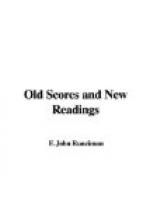In all Wagner’s music-plays there is shown an astonishing appreciation of the value and effect of scenery and of all the changes of weather and of skies and waters, not only as a background to his drama but as a means of making that drama clearer, of getting completer and intenser expression of the emotions for which the persons in the drama stand. The device is not so largely used in “Tristan” as in the other music-plays, yet the drama is enormously assisted by it. In the “Ring” it is used to such an extent that the first thing that must strike everyone is the series of gorgeously coloured pictures afforded by each of the four plays. For instance, no one can ever forget the opening of “The Valkyrie”—the inside of Hunding’s house built round the tree, the half-dead fire flickering, while we listen to the steady roar of the night wind as the tempest rushes angrily through the forest—nor the scene that follows, when through the open door we see all the splendours of the fresh spring moonlight gleaming on the green leaves still dripping with cold raindrops. The terror and excitement of the second act are vastly increased by the storm of thunder and lightning that rages while Siegmund and Hunding fight. A great part of the effect of the third act is due to the storm that howls and shrieks at the beginning and gradually subsides, giving way to the soft translucent twilight, that in turn gives way to the clear spring night with the dark blue sky through which the yellow flames presently shoot, cutting off Bruennhilde from the busy world. The same pictorial device is used throughout “Siegfried” with results just as magnificent in their way; though the way is a very different one. The drama of “The Valkyrie” is tragedy—chiefly Wotan’s tragedy (the relinquishing first of Siegmund, and his hope in Siegmund, then of Bruennhilde)—but incidentally the tragedy of Siegmund’s life and his death, of Siegmund’s loneliness and of Bruennhilde’s downfall; and at least one of the scenic effects—the fire at the end—was thrown in to relieve the pervading gloom, and in obedience to Wagner’s acute sense of the wild beauty of the old legend, rather than to illustrate and assist the drama. It is sheer spectacle, but how magnificent compared with that older type of spectacle which chiefly consisted of brass bands and ladies insufficiently clothed! “Siegfried,” on the other hand, contains no tragedy save the destruction of a little vermin. It is the most glorious assertion ever made of the joy and splendour and infinite beauty to be found in life by those who possess the courage to go through it in their own way, and have the overflowing vitality and strength to create their own world as they go. Siegfried is the embodiment of the divine energy that makes life worth living; and in the scenery, as in the tale and the music of the opera, nothing is left out that could help to give us a vivid and lasting impression of the beauty, freshness, strangeness, and endless interest of life. Take the first




